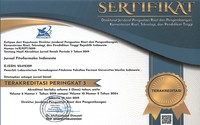Combination Gel Formulation Extracts of Moringa Leaf and Red Betel Leaf as an Inhibitor of Acne-Causing Bacteria (Propionibacterium acne and Staphylococcus aureus)
Abstract
Keywords
Full Text:
PDFReferences
Takanori igarashi, Ko Hishino, and Shree K, Hayar. The Appearance of Human skin. Departemen of Computer Science Columbia University, New York, NY 10027, USA, 2005.
Al-Hoqail, I. A. 2003. Knowledge, Beliefs and Perception of Youth Toward Acne Vulgaris. Saudi Med J. 24(7) : 765-768.
Mitsui, T. (1997). New Cosmetic Science. First Edition. Amsterdam: Elsevier Science B.V. Hal. 13,19-21.
Isitua CC, Ibeh IN, Olayinka JN. Antibacterial Activity Of Moringa oleifera Lamk. Leaves on Enteric Human Pathogens. Indian Journal of Applied Research. 2016; 6 (9) : 553-556. ISSN 2249-555X.
Rachmawaty FJ. Sirih Merah dalam Kajian Ilmiah. Yogyakarta: Aswaja Pressindo. 2017.
Kaur LP, Guleri T.k.2013, Topical Gel :A Recent Approach for Novel Drug delivery,Asian Journal of Biomedical and pharmaceutical Sciences 3,2013, 1-5
Mumpuni Yekti, Wulandari Ari. 2010. Cara Jitu Mengatasi Jerawat. Andi. Yogyakarta. Hal 3.
Kusantati Herni, DKK.2008. Tata Kecantikan Kulit umtuk SMK jilid 1, Jakarta: Direktorat Pembinaan Sekolah Menengah Kejuruan, Direktorat Jendral Manajemen Pendidikan Dasar dan Menengah, Departemen Pendidikan Nasional hal 74-75.
Harborne, J. B. Metode Fitokimia: Penuntun Cara Modern Menganalisa Tumbuhan (K. Padmawinata, dan I. Soediro, Penerjemah). Bandung: Penerbit ITB. 1996. h 207-211.
Shanson DC. 1982. Microbiology in Clinical Practise. Wright Bristol. London. Boston. 1982. Hlm 11-19.
DOI: https://doi.org/10.33096/jffi.v8i3.727
Copyright (c) 2021 Jurnal Fitofarmaka Indonesia

This work is licensed under a Creative Commons Attribution-ShareAlike 4.0 International License.
Indexed by:
ISSN: 2356-0398 | e-ISSN: 2541-2329
Editor's Address:
Third Floor Pharmacognosy-phytochemistry laboratory building, Urip Sumoharjo road km. 5 Campus II UMI, Makassar, South Sulawesi, Indonesia
Phone: +6281524045514
Fax: +62411425619
E-mail: editorjfi@umi.ac.id

















.jpg)

